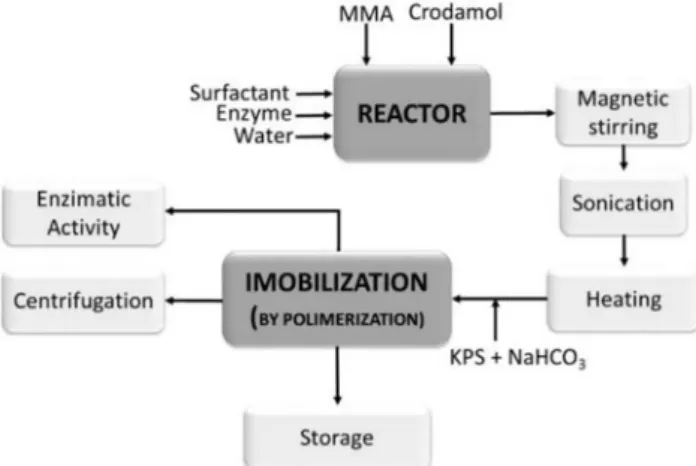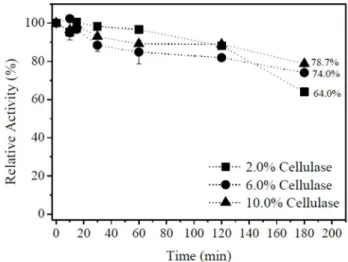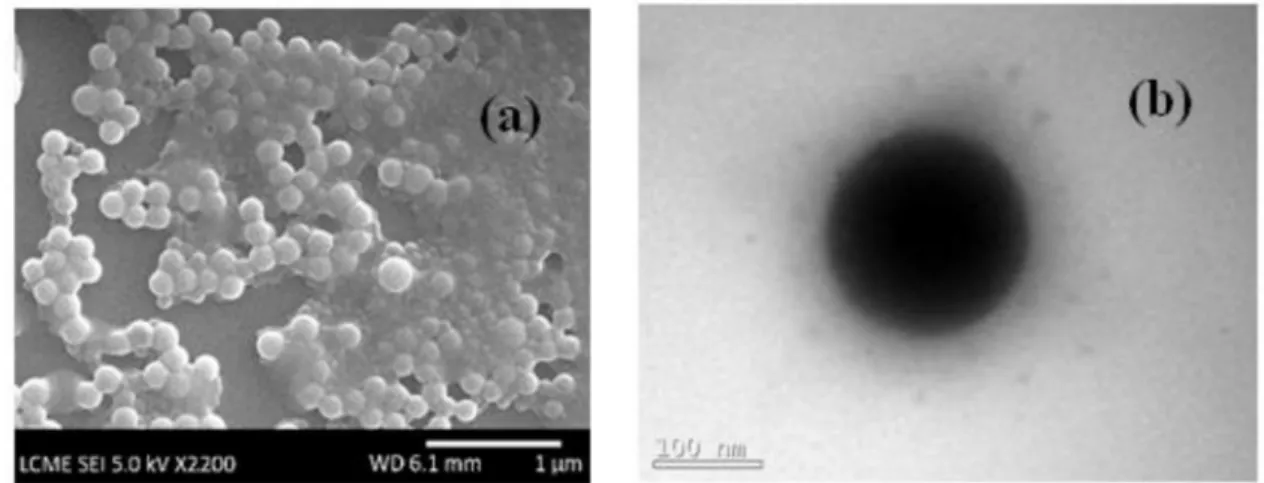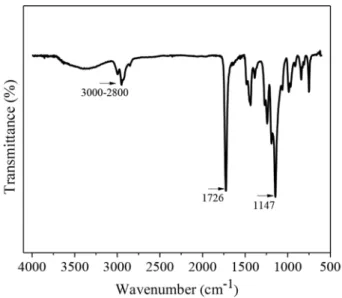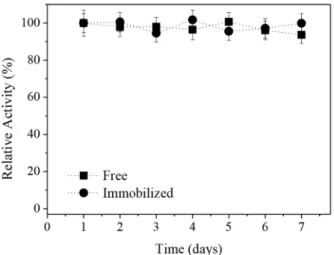of Chemical
Engineering
ISSN 0104-6632 Printed in Brazil www.scielo.br/bjce Vol. 35, No. 02, pp. 649 - 658, April - June, 2018
dx.doi.org/10.1590/0104-6632.20180352s20160094
CELLULASE IMMOBILIZATION ON
POLY(METHYL METHACRYLATE)
NANOPARTICLES BY MINIEMULSION
POLYMERIZATION
Patrícia Simon
1, Janaína S. Lima
1, Alexsandra Valério
1, Débora de
Oliveira
1, Pedro H. H. Araújo
1, Claudia Sayer
1, Antônio Augusto U. de
Souza
1and Selene M. A. Guelli U. de Souza
1* 1 Departamento de Engenharia Química e Engenharia de Alimentos, UniversidadeFederal de Santa Catarina, PO Box 476, CEP 88040-900 Florianópolis, SC, Brasil
(Submitted: February 12, 2016; Revised: January 17, 2017; Accepted: January 22, 2017)
Abstract - Cellulases are efficient enzymes for the conversion of cellulose into glucose. Their use in immobilized
form enables them to be reused in successive cycles in many biotechnological processes. Unlike conventional methods of immobilization by covalent bonding, in miniemulsion polymerization the immobilization of enzyme and the synthesis of polymer nanoparticles (support) occur simultaneously. Based on these aspects, the immobilization of cellulose on poly(methyl methacrylate) (PMMA) nanoparticles by miniemulsion polymerization was studied. The surfactant type (non-ionic and ionic) and latex pH showed great influence on cellulase activity. High activity values were obtained only when non-ionic surfactant (Lutensol AT50) and buffering agent (NaHCO3) were used
simultaneously. MMA polymerization rate and final monomer conversion were not affected by the presence of cellulase. The maximum immobilization efficiency (60%) was obtained when 6 wt.% of cellulase was used and stable PMMA nanoparticles (133 nm) were obtained. The relative activity profile of immobilized cellulase, for pH as well as temperature, was similar to that reported for the free form. Immobilized enzyme keeps its activity throughout seven days when stored at 4 ºC and phosphate buffer pH 6.0. Based on the results obtained in this work, miniemulsion polymerization as a method for cellulase immobilization on PMMA nanoparticles showed to be a promising technique with high possibility of industrial application.
Keywords:Cellulase, Immobilization, Polymeric nanoparticles, Miniemulsion polymerization.
INTRODUCTION
Due to their biotechnological potential, cellulases
contribute to the improvement of several processes, including food, textile, paper and cellulose industries,
agriculture and, more recently, second-generation ethanol production. For this reason, these enzymes
have been studied by several research groups both in the academic and industrial scope (Kuhad and Singh,
2011). Although the use of cellulase is widespread in several areas, its use in free form, as well as other enzymes, has some unfavorable aspects such as low stability in solution, high isolation and purification costs, and especially the difficulty of recovery from
Brazilian Journal of Chemical Engineering
the reaction medium for subsequent reuse. As a result, the industrial application of cellulases is still a costly
process (Daoud et al., 2010; Sheldon and Van Pelt,
2013). By biocatalyst immobilization, many of these drawbacks can be overcome, reflecting in economic benefits.
Nanoscale supports are very attractive for immobilization of enzymes since they can improve significantly biocatalyst efficiency. The reduced size provides a larger surface area for immobilization, enabling an increased amount of enzyme per particles and reducing the diffusion boundaries (Ansari and
Husain, 2012; Jia et al., 2003). The most common
ways to link an enzyme to nanoparticles are through
electrostatic adsorption, covalent attachment to
surface modified nanoparticles, direct conjugation to the nanoparticle surface and conjugation using specific affinity of protein (Ahmad and Sardar, 2015;
Sheldon and Van Pelt, 2013; Elnashar, 2010). These approaches generally involve at least two steps, one
for obtaining the support and another for enzyme immobilization, which usually requires a lot of time.
Thus, miniemulsion polymerization is emerging as a promising technique to immobilize enzymes on polymer nanoparticles in a single-step without the
use of organic solvents. In other words, the synthesis of polymeric support and immobilization of enzyme occur concurrently, eliminating the extra steps for functionalization and immobilization.
Miniemulsion polymerization is defined as a relatively stable dispersion of oil droplets in water in a size range of 50-500 nm. The oil nanodroplets are obtained by application of high shear in a system containing oil, water, surfactant and costabilizer (Antonietti and Landfester, 2002; Landfester et al., 1999). The high stability of the polymer nanoparticles obtained is a result of the combined effects of surfactant and cosurfactant, which suppress coalescence and Ostwald ripening, respectively (Crespy and Landfester, 2010). Thus, the proper choice of surfactant and a
stabilizer as well as their amounts are very important
to obtain stable nanoparticles for long periods.
Cipolatti et al. (2014) reported efficient immobilization of lipase CalB on PEGylated nanoparticles of poly(urea-urethane) (PUU) during step
growth miniemulsion polymerization. Immobilized enzyme showed higher enzymatic activity and higher
thermal stability than free CalB enzyme. Valério et al. (2015) immobilized lipase CalB on well-defined PMMA core-shell nanoparticles during free radical
miniemulsion polymerization. The authors showed that, by applying this technique it was possible to
obtain 75% of immobilization yield. Immobilized enzyme had a higher operational stability than free
enzyme.
Despite the aforementioned promising works, this approach still requires further studies, because the effects of reaction conditions on enzyme activity
are not yet entirely elucidated (Cipolatti et al., 2014; Valério et al., 2015). For instance, due to the quite
specific actuation of each enzyme, different enzymes may present distinct behaviors, as well as effects on miniemulsion polymerization. The few works found in
the literature employ miniemulsion polymerization as
a technique for immobilization of enzymes and they are restricted to immobilization of lipase (Cipolatti et al,
2014; Valério et al., 2015; Chiaradia et al., 2016). Thus,
aiming to contribute with the development of effective
and innovative cellulase immobilization techniques,
this paper presented a study of immobilization of a
commercial cellulase on PMMA nanoparticles during miniemulsion polymerization.
MATERIALS AND METHODS
Materials
Free cellulase (Cellusoft CR) was kindly donated
by Novozymes Brasil (Araucária, PR, Brazil). In the miniemulsion polymerization Crodamol GTCC,
a triglyceride of capric and caprylic acids, used as costabilizer, was provided by Alfa Aesar and either Lutensol AT50 from BASF, or sodium dodecyl sulfate (SDS, Sigma-Aldrich) was used as a surfactant. Methyl methacrylate (MMA, 99.5%) monomer, initiator potassium persulfate (KPS, P.A) and buffer
sodium bicarbonate (NaHCO3, P.A) were provided by Sigma-Aldrich. Sodium hydroxide (NaOH, P.A)
was acquired from Lafan Ltda. Potassium and sodium
tartrate (P.A) were both provided by Synth. Glucose D(+) anhydrous dextrose (P.A), 3,5-dinitrosalicylic acid (DNS, P.A), monobasic anhydrous potassium phosphate (P.A), dibasic sodium dihydrogen phosphate (P.A), and sodium carboxymethylcellulose (CMC) were all provided by Sigma-Aldrich. Cellulose acetate
membranes (Unifil, 47 mm, 0.45 µm) and qualitative filter paper was used to determine enzymatic activity.
Amicon® Ultra Centrifugal Filters (0.5 mL, 100.000Da)
were used in the sample centrifugation. All reagents were used as received without previous purification.
Cellulase immobilization by miniemulsion polymerizationon PMMA nanoparticles
The synthesis of PMMA nanoparticles followed
et al. (2015), with some modifications. The aqueous phase (distilled water, surfactant (Lutensol AT50
or SDS) and enzyme) and organic phase (Crodamol and monomer, MMA) were prepared according to
the formulation shown in Table 1. Initiator (KPS)
and sodium bicarbonate (NaHCO3) (when used)
were dissolved in an aliquot of the water phase and added to the dispersion after sonication, beginning the
polymerization process. Reactions were carried out
under constant magnetic stirring at 70 ºC for 3 h, in a jacketed borosilicate glass reactor (50 mL).
With the immobilization process ended, the
final colloidal suspension of PMMA-cellulase
(latex) was used to determine the enzyme activity and thermal stability at 4 ºC and room temperature, in order to determine the nanoparticles stability and the immobilized enzyme storage stability. To
determine the immobilization efficiency, the final colloidal suspension of PMMA-cellulase (latex) was centrifuged at 11.300 g for 30 min in an Eppendorf - MiniSpin centrifuge, making use of ultrafiltration devices (Amicon® filters - 0.5 mL, 100.000Da), and the permeate was used for the analysis. Fig. 1 presents
schematically the described procedure.
Enzyme activity assays
The cellulase activity was determined by the DNS
method, following the procedure described: 900 µL of 4% (m/v) CMC solution, in phosphate buffer (0.05 M, pH 6.0), and 100 µL of PMMA-cellulase colloidal suspension were incubated at 55 ºC for 30 minutes. After the incubation time, 1.5 mL of DNS was added.
The resulting solution was heated in a boiling water
bath for 5 minutes and cooled in an ice bath, followed by water addition for sample dilution. These samples were then filtered in qualitative filter paper and cellulose acetate membranes for particulates removal.
Finally, the glucose amount produced was determined
from the absorbancea t540 nm. The relation between
absorbance and concentration was achieved through a calibration curve, using glucose as standard.
In order to avoid interferences, a control solution was prepared for all experiments, adding 1.5 mL of
DNS to the CMC and PMMA-cellulase solution at
the beginning of enzymatic hydrolysis. One cellulose activity (U) unit was defined as glucose amount generated per minute (µmol/min). All measurements were performed in duplicate. The relative activity
(AR) (Equation 1), where noted, was expressed as
percentage of enzyme activity at a specific value (AEi) relative to the maximum activity (AEmax). Maximum activity is the highest activity among all activities
values obtained for the variable under study.
(1) Free enzyme activity was determined in accordance with procedures and conditions used to determine the
activity of the immobilized enzyme, excluding only the filtration steps.
Table 1. .Experiments performed to study the effect of pH, surfactant type and concentration on enzymatic activity and polymer particle size.
Exp. SDS (g) Lutensol AT50 (%)* NaHCO3(g) Latex pH Dp**(nm) PDI EA (U/mL)
1 - 2.7 0.01 6.5 131 ± 0.3 0.145 368.9 ± 2.8
2 - 2.7 - 3.0 128 ± 1.1 0.164 16.8 ± 3.1
3 0.060 - 0.01 5.1 *** *** 37.8 ± 11.5
4 0.060 - - 3.0 *** *** 1.8 ± 0.26
5 - 1.4 0.01 6.5 193 ± 1.4 0.398 319 ±3.0
6 - 4.0 0.01 6.3 112 ± 0.7 0.185 386 ±6.0
wt.% related to the total weight of the reaction medium. ** Values expressed as mean ± standard deviation. *** Unstable emulsion.
All reactions were performed at 70 °C during 3 h under constant magnetic stirring with: 3.09 g MMA, 3.03 g Crodamol, 0.30 g cellulase, 0.03 g KPS, 24 g
Figure 1. Schematic procedure for cellulase immobilization by
miniemulsion polymerization
x
AR
AE
AE
100
max
i
Brazilian Journal of Chemical Engineering Immobilization efficiency
The amount of cellulase immobilized (Yimob) on the PMMA nanoparticles was determined using Equation 2.
(2) in which Afree is the free enzyme activity before
the immobilization process (U/mL); Asupernatant is the
supernatant activity after immobilization (U/mL).
Polymer characterization
The monomer conversion (MMA) was determined
by gravimetric method. Latex samples were taken at different time intervals and added to previously
pre-weighted aluminum capsules containing 0.2
g of hydroquinone aqueous solution (1 wt.%) to
immediately stop reaction. The capsules were then
dried at 60 ºC in a forced convection oven until
constant weight. Conversion was calculated relating
the polymer mass present in the reactor and the fed
monomer mass.
The intensity average diameter (Dp) of the PMMA
nanoparticles was determined by the dynamic light scattering technique (DLS - Malvern Instruments,
Zetasizer Nano S); for the measurements, samples
were diluted in distilled water. Scanning electronic
microscopy with field emission (MEV-FEG - JEOL JSM-6701, LCME UFSC) was used in order to verify the morphology of PMMA nanoparticles. Sample preparation was performed by dropping the diluted latex (1:23 in distilled water) on a stub. After complete
drying, the samples were sputter coated with a thin gold layer and analyzed.
Attenuated total reflectance Fourier Transform Infrared Spectroscopy (ATR-FTIR- Bruker TENSOR 27) in the range from 600 to 4000 cm-1 was used to
confirm the chemical structure of the PMMA.
Effect of pH and temperature on enzymatic activity
In order to determine the influence of pH and temperature on free and immobilized cellulase, the activity assays were carried out in a range of pH from 4.0 to 8.0, and in a range of temperature from 35 to
75 ºC. Thermal stability was determined by measuring
enzymatic activity of free and immobilized cellulase using the previously described procedure at different
incubation times (30-300 min).
Storage stability
The storage stability of free and immobilized
cellulose at 4 ºC was monitored by measuring the
enzyme activity during 7 days. For this analysis free enzymes were kept in phosphate buffer (0.05M, pH 6.0), and the final latex was used as prepared (latex
storage).
RESULTS AND DISCUSSION
Influence of the surfactant type and pH on the en -zymatic activity
The influence of pH and surfactant type (anionic
- SDS or non-ionic - Lutensol AT50) used in the miniemulsion polymerization, on the cellulase
enzymatic activity, was evaluated using different polymerization formulations. The results are shown in Table 1. For experiments conducted with different surfactants and at the same pH (experiments 2 and 4),
it was observed that the enzymatic activity was almost
10 times higher when non-ionic surfactant (Lutensol AT50) was used. The negative influence of ionic surfactants on cellulase hydrolysis was also reported by Eriksson et al. (2002) and Ueda et al. (1994).
All reactions were performed at 70 ºC during 3 h
under constant magnetic stirring with: 3.09 g MMA, 3.03 g Crodamol, 0.30 g cellulase, 0.03 g KPS, 24 g water.
Comparing the experiments performed with the same surfactant and at different pH (experiments
1 and 2), it is noted that the enzymatic activity was much greater when NaHCO3was employed. A possible
explanation for these results is the latex pH was under
the enzyme stability range, causing its denaturing. From experiment 1, the latex pH was in the optimum
range of enzyme activity (determined previously for free enzyme) upon adding only 0.01 g of buffering
agent (NaHCO3). According to these results, it can
be concluded that the concomitant use of a non-ionic surfactant and a buffer is necessary to obtain high
enzymatic activities.
Effect of surfactant concentration
The effect of Lutensol AT50 concentration on
nanoparticle diameter was investigated. According to Table 1, the nanoparticle diameter (Dp) and dispersion
(PDI) decreased upon increasing the surfactant concentration. The interfacial tension decreases with
%
Y
imobA
A
A
sup tan freefree erna t
=
increasing surfactant concentration, facilitating the dispersion of the monomer droplets during sonication,
thus reducing nanoparticle diameter (Antonietti and
Landfester, 2002; Bechthold et al., 2000; Romio et al.,
2009; Valério et al., 2013). The polymeric nanoparticle
surface area per surfactant molecule (Asurf) was
reduced from approximately 1.77 to 1.02 nm2/
surfactant molecule when increasing the surfactant concentration from 1.4 to 4.0 wt.%. It means that the higher surfactant concentration increased the packing density of surfactant molecules at the particle surface. For non-ionic surfactant, steric stabilization is the main mechanism for the nanoparticle stabilization and it arises from a physical barrier. The surfactant molecules adsorbed on the surface of the nanoparticles
extend into the continuous phase, providing a volume
restriction or a physical barrier for particle interactions
that prevents aggregation or coalescence and hence
stabilizes emulsions. The higher the packing density of surfactant molecules at the particle surface, more effective is the physical barrier and higher is the
nanoparticle stability, as was observed.
Influence of cellulase concentration
The effect of enzyme concentration on the relative
activity during miniemulsion polymerization,
immobilization efficiency, particle diameter and
monomer conversion was also studied. According to
the results shown in Fig. 2, it can be verified that the
relative activity decreased during the polymerization
for all concentrations of enzymes tested. A similar
behavior was reported by Valérioet al. (2015) using
the miniemulsion polymerization technique for CalB
lipase immobilization.
Due to the immobilization process, part of the
enzyme catalytic activity can be compromised. However, the relative activity obtained by the
immobilization method used in the current work (64-78.7%) is equal to or higher than those reported for
other immobilization methods by covalent bonds
(Jordan et al., 2011; Silva et al., 2012; Abd El-Ghaffar
and Hashem, 2010).
By measuring the supernatant enzyme activity, it could be observed that the highest immobilization
efficiency was obtained when 6 wt.% of cellulase was used. At this concentration, approximately 60% of the initial enzyme activity was retained on PMMA nanoparticles. As shown in Table 2, at 10 wt.% of
enzyme an expressive reduction in immobilization
efficiency was observed. At low enzyme concentration the packing factor is lower than at higher enzyme
concentration. However, there is a saturation point
where the surface of the nanoparticle is fully covered by enzyme and the packing factor is maximum. Thus,
increasing enzyme concentration above this point, a greater non-immobilized enzyme concentration is detected in the supernatant, leading to a decrease in
immobilization efficiency.
According to Table 2, different concentrations of enzyme did not affect the particle size. Furthermore, there was not any evidence of the formation of
coagulum during the polymerization reaction. These
results suggest that, for all enzyme concentrations
tested, the miniemulsions were stable. The enzyme
concentration did not affect MMA conversion and for all reactions MMA conversion was above 90%. Similar
behavior was observed by Valério et al. (2015).
Table 2. Influence of cellulase concentration on immobilization yield and nanoparticle diameter (Dp) and dispersion (PDI).
Cellulase Concentration (relative to
MMA, wt.%) Immobilization Yield (%) Dp (nm)* PDI
0 132±1.0 0.154
2 47±2 136±0.6 0.197
6 59±1 133±0.8 0.176
10 22±2 138±0.5 0.168
*values are expressed as mean ± standard deviation
Figure 2. Influence of cellulase concentration on relative activity during
Brazilian Journal of Chemical Engineering Stability of PMMA-cellulase nanoparticles
The average size of PMMA nanoparticles was
monitored during 60 days (Fig. 3). A colloidal
dispersion of PMMA-cellulase nanoparticles was
stored at room temperature and at 4ºC to determine the
effect of temperature on nanoparticle stability.
Figure 3. PMMA-cellulase nanoparticle (synthesized using 2.7 wt.%
of Lutensol AT50 and 6 wt.% of cellulase) stability at 4 °C and at room temperature.
As observed in Fig. 3, the nanoparticle diameter
slightly increased for both temperatures after 60 days of storage and the formation of coagulum was not
observed indicating that the dispersion was stable and
could be stored for long periods.
The MEV-FEG image (Fig. 4a) shows that PMMA nanoparticles had a spherical morphology and the particle size is in the same range as that obtained by
Figure 4. MEV-FEG (a) and TEM (b) images of PMMA-cellulase nanoparticles synthesized using 2.7 wt.% Lutensol AT50 and 6
wt.% cellulase.
DLS. As cellulase is predominantly lipophobic and it is dispersed in the water phase, the interaction between
the lipophilic groups of the enzyme and PMMA occurs only at the surface of the nanoparticle, resulting in a
core-shell structure where the immobilized enzyme
remains at the nanoparticle surface. The TEM image
(Fig. 4b) shows a polymer nanoparticle with a shadow around it that could be attributed to cellulase.
The chemical structure of PMMA wasverified
by ATR-FTIR and the PMMA spectrum is shown
in Fig. 5. The peak at 1147 cm-1is assigned to the
stretching vibration mode of C-O-C of the ester group. The peak at 1726 cm-1 is attributed to stretching of the
carbonyl group of PMMA. The absorption bands in the
range 3000-2800 cm-1 are attributed to stretching of C
-H bonds of PMMA (Feuser et al., 2015; Matsushita et al., 2000). The absence of peaks at 1640 cm-1 is an
evidence of complete polymerization of the monomer. This peak is attributed to C=C groups that are present
in the monomer molecules that are directly involved in
the polymerization (Otsuka and Chujo, 2010).
Effect of pH and temperature on enzyme activity
The effect of pH and temperature on the activity of free and immobilized enzyme is shown in Figs. 6 and 7. As can be observed, both free and immobilized
enzymes are sensitive to pH and temperature
variations. After immobilization, the relative activity profile for pH as well as temperature behavior was similar to that reported for free enzymes. Besides that, the maximum activity for free and immobilized enzymes was obtained at pH 6.0 and temperature of
reported by Liang and Cao (2012) for immobilized
cellulase on polyacrylate copolymer.
Thermal stability
The thermal stabilities of free and immobilized
cellulase were compared by measuring their activities over time at constant temperature (55 ºC). Fig. 8 shows
that free and immobilized cellulase activity decreased
gradually with time. Although the immobilized
enzyme is inserted in a medium consisting of various components (water, ions, surfactant, etc.) that may affect its activity, its thermal stability was not affected.
Figure 5. FTIR spectrum of PMMA nanoparticles synthesized using 2.7
wt.% of Lutensol AT50.
Figure 6. Effect of pH on enzymatic activity of free and immobilized
cellulose at 55 ºC (PMMA-cellulase nanoparticles synthesized using 2.7 wt.% Lutensol AT50 and 6 wt.%).
Figure 7. Effect of temperature on enzymatic activity of free and
immobilized cellulase at pH 6.0 (PMMA-cellulase nanoparticles synthesized using 2.7 wt.% Lutensol AT50 and 6 wt.% cellulase)
Figure 8. Thermal stability of free and immobilized cellulase at 55 °C
and pH 6.0 (PMMA-cellulase nanoparticles synthesized using 2.7 wt.% Lutensol AT50 and 6 wt.% cellulase).
Storage stability
The storage stability of an enzyme is one of the main factors to evaluate its technological feasibility. Fig. 9 shows the stability of free and immobilized cellulase stored in phosphate buffer (0.05 M, pH 6.0) at 4 ºC.
It was observed that the relative activity remained
constant during 7 days for free and immobilized
cellulase. According to Cavaco and Gübits (2003),
temperature is a critical factor during enzyme storage, in both their solid and liquid forms. The results suggest that the latex did not interfere in the activity of immobilized cellulase under the tested conditions and these conditions (phosphate buffer pH 6.0 at 4 ºC) were suitable for enzyme conservation. Furthermore,
at this temperature the microbial degradation can be minimized.
The immobilized cellulase was evaluated for four successive cycles and 22% of the initial activity was kept, showing the possibility of reusing the
Brazilian Journal of Chemical Engineering CONCLUSIONS
In this work, miniemulsion polymerization was used as a technique for cellulase immobilization
on poly(methyl methacrylate) (PMMA) polymeric nanoparticles. Polymerizations with non-ionic
surfactant, Lutensol AT50, concomitantly with a buffering agent, NaHCO3, led to high enzymatic
activity values. From the study of the effect of surfactant concentration, 2.7 wt.%of Lutensol AT50 was sufficient to obtain stable nanoparticles with a
high enzyme activity value. The increase in enzyme concentration in the polymerization reactions led
to higher relative activity values at the end of the
reactions. A cellulase concentration study indicated
that the maximum immobilization yield was 60%, obtained when 6 wt.% of cellulase was added. Both free and immobilized enzymes presented the same
behavior in relation to thermal stability, having their
relative activity values reduced to 50% after 60 min of
hydrolysis at 55 ºC and pH 6.0. In relation to storage
stability, it was verified that immobilized enzyme keeps its activity throughout seven days when stored at 4 ºC in phosphate buffer, pH 6.0. Based on the results presented in this work, the immobilization of cellulase
on PMMA polymeric nanoparticles by miniemulsion
polymerization can be seen as a promising, feasible and
innovative technique, which aims to cooperate with improvement, in both an economic and environmental
sense, of several productive industrial processes.
ACKNOWLEDGMENTS
The authors would like to thank the Conselho Nacional de Desenvolvimento Científico e Tecnológico
Figure 9. Storage stability of free and immobilized cellulase at 4 °C
(PMMA-cellulase nanoparticles synthesized using 2.7 wt.% Lutensol AT50 and 6 wt.% cellulase).
(CNPQ), Coordenação de Aperfeiçoamento de Pessoal
de Nível Superior (CAPES) and Laboratório Central
de Microscopia Eletrônica of Federal University of
Santa Catarina (LCME-UFSC).
REFERENCES
Abd El-Ghaffar, M.A. and Hashem, M.S., Chitosan
and its amino acids condensation adducts as
reactive natural polymer supports for cellulase
immobilization. Carbohydrate Polymers, 81 507-516 (2010).
Ahmad, R.; Sardar, M., Enzyme Immobilization: An Overview on Nanoparticles as Immobilization Matrix. Biochemistry & Analytical Biochemistry, 4(2), 1 (2015).
Ansari, S.A. and Husain, Q., Potential Applications
of enzymes immobilized on/in nano material:
A review. Biotechnology Advances, 30 512-523 (2012).
Antonietti, M. and Landfester, K., Polyreactions in
miniemulsions. Progress in Polymer Science, 27 689-757 (2002).
Bechthold, N., Tiarks, F., Willert, M., Landfester, K.
and Antonietti, M., Miniemulsion Polymerization: Applications and New Materials. Macromolecular Symposia, 151 549-555 (2010).
Börjesson, J., Peterson, R. and Tjerneld, T., Enhanced
enzymatic conversion of softwood lignocellulose
by poly(ethylene glycol) addition. Enzyme and Microbial Technology, 40 754-762 (2007).
Cavaco-Paulo, A. and Gübitz, G.M., Textile processing with Enzymes. 1.ed. England: Woodhead Publishing Ltd, 2003. 204 p.
Chiaradia, V.; Valério, A., Oliveira, D., Araújo, P.H.H., Sayer, C., Simultaneous single-step immobilization
of Candida antarctica lipase B and incorporation
of magnetic nanoparticles on poly(urea-urethane) nanoparticles by interfacial miniemulsion polymerization. Journal of Molecular Catalysis B:
Enzymatic, 131 31-35 (2016).
Cipolatti, E.P., Valério, A., Nicoletti, G., Theilacker, E.,
Araújo, P.H.H., Sayer, C., Ninow, J.L. and Oliveira,
D., Immobilization of Candida antarctica lipase B on PEGylated-poly(urea-urethane) nanoparticles
by step miniemulsion polymerization. Journal of
Molecular Catalysis B: Enzymatic, 109 116-121 (2014).
Crespy, D., Landfester, K., Miniemulsion polymerization as a versatile tool for the synthesis of functionalized polymers. Beilstein Journal of
Daoud, F.B., Kaddour, S. and Sadoun, T., Adsorption
of cellulase Aspergillus niger on a commercial activated carbon: Kinetics and equilibrium studies.
Colloids and Surfaces B: Biointerfaces, 75 93-99
(2010).
Elnashar, M.M.M., Review Article: Immobilized Molecules Using Biomaterials and
Nanobiotechnology. Journal of Biomaterials
Nanobiotechnology, 1 61-77 (2010).
Eriksson, T.; Börjeson, J.; Tjerneld, F., Mechanism ofsurfactant effect in enzymatic hydrolysis of
lignocellulose. Enzyme and Microbial Technology, 31, 353-364, 2002.
Feuser, P. E., Bubniak, L. S., Silva, M.C.S., Viegas,
A.C., Fernandes, A.C., Ricci-Junior, E., Nele, M., Tedesco, A.C., Sayer, C., Araújo, P.H.H.,
Encapsulation of magnetic nanoparticles in
poly(methyl methacrylate) by miniemulsion
and evaluation of hyperthemia in U87MG cells.
European Polymer Journal, 68 355-365 (2015). Jia, H., Zhu, G. and Wang, P., Catalytic Behaviors
of Enzymes Attached to Nanoparticles: The Effect of Particle Mobility. Biotechnology and
Bioengineering, 84 406-414 (2003).
Jordan, J., Kumar, C.S.S.R. and Theegala, C.,
Preparation and characterization of cellulose-bond magnetite nanoparticles. Journal of Molecular
Catalysis B: Enzymatic, 69 139-146 (2011).
Landfester, K., Bechthold, N., Förster, S. and Antonietti, M., Evidence for the preservation of the
particle identity in miniemulsion polymerization. Macromolecules Rapid Communications, 20 81-84 (1999).
Liang, W. and Cao, X., Preparation of a
pH-sensitive polyacrylate amphiphilic copolymer and its application in cellulase immobilization. Bioresource Technology, 116 140-146 (2012).
Matsushita, A., Ren, Y., Matsukawa, K., Inoue, H., Minami, Y., Noda, S., Ozaki, Y., Two-dimensional
Fourier-transform Raman and near-infrared correlation spectroscopy studies of poly (methyl methacrylate) blends1. Immiscible blends of poly
(methyl methacrylate) and atactic polystyrene. Vibrational Spectroscopy, 24 171-180 (2000).
Otsuka, T., Chujo, Y., Poly(methyl methacrylate)
(PMMA)-based hybrid materials with reactive zirconium oxide nanocrystals. Polymer Journal, 42 58-65 (2010).
Romio, A.P., Sayer, C., Araujo, P.H.H., Al-Haydari, M., Wu, L. and Rocha, S.R.P., Nanocapsules by Miniemulsion Polymerization with Biodegradable
Surfactant and Hydrophobe. Macromolecular
Chemistry and Physics, 210 747-751 (2009). Sheldon, R.A. and Van Pelt, S., Enzyme immobilization
in biocatalysis: why, what and how. Chemical Society Reviews, 42 6223-6235 (2013).
Silva, J.A., Macedo, G.P., Rodrigues, D.S., Giordano, R.L.C. and Gonçalves, L.R.B., Immobilization
of Candida antarctica Lipase B by covalent attachment on chitosan-based hydrogels using
different support activation strategies. Biochemical
Engineering Journal, 60 16-24 (2012).
Ueda, M., Koo, H. and Wakida, T., Cellulase treatment of cotton fabrics. Part II: Inhibitory Effect of Surfactants on Cellulase Catalytic Reaction. Textile
Research Journal, 64 615-618 (1994).
Valério, A., Araújo, P.H.H. and Sayer, C., Preparation
of Poly(Urethane-urea) Nanoparticles Containing
Açaí Oil by Miniemulsion Polymerization. Polímeros, 23, 451-455 (2013).
Valério, A., Nicoletti, G., Cipolatti, E.P., Ninow, J.L., Araújo, P.H.H., Sayer, C. and Oliveira, D.
